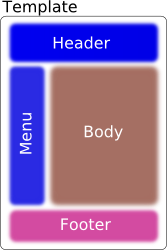

WARNING!!! Configuration with initialization parameters is deprecated! If you still want to use it, please refer to 2.1 version of this page.
After installing and learning some of Tiles concepts, it is time to create some pages. Here you will find the steps to create reusable Tiles pieces and complete pages.
Let's take the classic layout page structure:

Create a JSP page that acts as this layout and place it under /layouts/classic.jsp file.
<%@ taglib uri="http://tiles.apache.org/tags-tiles" prefix="tiles" %>
<html>
<head>
<title><tiles:getAsString name="title"/></title>
</head>
<body>
<table>
<tr>
<td colspan="2">
<tiles:insertAttribute name="header" />
</td>
</tr>
<tr>
<td>
<tiles:insertAttribute name="menu" />
</td>
<td>
<tiles:insertAttribute name="body" />
</td>
</tr>
<tr>
<td colspan="2">
<tiles:insertAttribute name="footer" />
</td>
</tr>
</table>
</body>
</html>
This template has five attributes: title (of string type), header, menu, body and footer.
In this phase, you have to create four JSP pages, that will take place of header, menu, body and footer attributes in the previously created template.
You can put everything you want in this pages, they are just a test.
To load the Tiles definition files, override the getSourceURLs method of BasicTilesContainerFactory this way:
public class TestTilesContainerFactory extends BasicTilesContainerFactory {
@Override
protected List<URL> getSourceURLs(TilesApplicationContext applicationContext,
TilesRequestContextFactory contextFactory) {
List<URL> urls = new ArrayList<URL>();
try {
urls.add(applicationContext.getResource("/WEB-INF/tiles-defs.xml"));
} catch (IOException e) {
throw new DefinitionsFactoryException(
"Cannot load definition URLs", e);
}
return urls;
}
}
Create the Tiles listener along with an inner class that represents the initializer:
public class TestTilesListener extends AbstractTilesListener {
@Override
protected TilesInitializer createTilesInitializer() {
return new TestTilesListenerInitializer();
}
private static class TestTilesListenerInitializer extends AbstractTilesInitializer {
@Override
protected AbstractTilesContainerFactory createContainerFactory(
TilesApplicationContext context) {
return new TestTilesContainerFactory();
}
}
}
Define the listener in web.xml
<listener> <listener-class>my.package.TestTilesListener</listener-class> </listener>
Create the /WEB-INF/tiles-defs.xml file:
<?xml version="1.0" encoding="ISO-8859-1" ?>
<!DOCTYPE tiles-definitions PUBLIC
"-//Apache Software Foundation//DTD Tiles Configuration 2.1//EN"
"http://tiles.apache.org/dtds/tiles-config_2_1.dtd">
<tiles-definitions>
<definition name="myapp.homepage" template="/layouts/classic.jsp">
<put-attribute name="title" value="Tiles tutorial homepage" />
<put-attribute name="header" value="/tiles/banner.jsp" />
<put-attribute name="menu" value="/tiles/common_menu.jsp" />
<put-attribute name="body" value="/tiles/home_body.jsp" />
<put-attribute name="footer" value="/tiles/credits.jsp" />
</definition>
</tiles-definitions>
After creating the definition, you can render it:
<%@ taglib uri="http://tiles.apache.org/tags-tiles" prefix="tiles" %> <tiles:insertDefinition name="myapp.homepage" />
TilesContainer container = TilesAccess.getContainer(
request.getSession().getServletContext());
container.render("myapp.homepage", request, response);